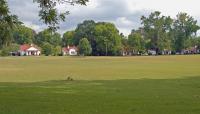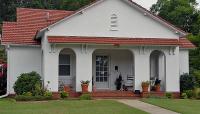Landscape Information
The Manhattan-based landscape architect Harold A. Caparn was assigned during World War I to lay out three industrial villages as housing for supervisors and workers on projects in northwest Alabama. Village No. 1 (or Nitrate Village) was attached to Plant No. 1, that was testing a process to produce ammonium nitrate, essential in munitions to win the war. Located just outside Sheffield along the Tennessee River, the village consisted of 85 homes, a school/community center, and a barracks for unmarried officers, as well as the home of the commanding officer of the Army Corps of Engineers who directed the projects.
After planning with the New York-based Mann & MacNeille architects and J. G. White Construction Company, Caparn spent August through early November 1918 on site. His design took as its model the English handbell, with streets surrounding parks at the handle, body and clapper and at its school base. Surrounding the handbell shape, the homes were all designed in the Mission style using mass design and production techniques. The village’s form symbolized Caparn’s hope for liberty for his native United Kingdom and for the U.S., his naturalized country of citizenship. The village was listed in the National Register of Historic Places in 1984.








